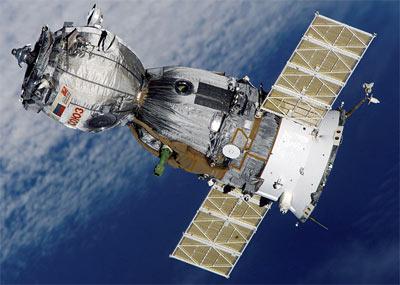Soyuz-TMA 1 - 22 (7K-STMA, 11F732A17) (original) (raw)

Soyuz-TMA 7 [NASA]
The Soyuz TMA crewed spacecraft has been developed as a modification on the basis of a Soyuz TM spacecraft in accordance with intergovernmental agreements between Russia and the USA and is an integral part of the International Space Station (ISS) Complex. It is to provide rescue of the main crew of the station in emergency and delivery of visiting crews.
During the flight the spacecraft fulfills the following tasks:
- delivery of a visiting crew consisting of up to three persons and small accompanying cargoes
- constant availability of the spacecraft, attached to the station during its crewed flight, in the standby mode to be ready for emergency descent of the main crew onto the ground in case of hazardous situation on the station, cosmonaut illness or injury, etc. (assured crew return vehicle function);
- planned descent of the visiting crew onto the ground;
- returning to the ground, together with the crew, payloads of relatively low mass and volume
- disposal of wastes from the station in the living compartment to be burned down in the atmosphere during descent.
The basic modifications of the Soyuz TM spacecraft are connected with implementation of requirements for enlargement of crew anthropometric parameter range up to the values acceptable for the American astronaut contingent, and with increase of crew protection level from shock loads by decreasing landing speeds and improving shock-absorption of its chairs.
To denote the modification of this spacecraft in design and general technical documentation, the name "Soyuz TMA" (anthropometric) was adopted.
For implementation of the above requirements on the baseline Soyuz TM spacecraft the following basic modifications in layout, design and onboard systems of the descent module (DM) were made without increase of its dimensions:
- Three newly developed long Kazbek-UM amortization chairs with new four-mode dampers that provide chair adjustment, depending on the astronaut mass.
- A re-arrangement of equipment was made in the areas above and below DM chairs which allows one to accommodate longer chairs and astronauts with increased anthropometry and to enlarge the passage area through the access hatch. In particular, a new control panel decreased in height, a new cooling-drying assembly, data storage system and other new or modified systems are installed.
- On the DM primary structure in the area of right and left chair footrests the cavities were stamped about 30 mm deep that allowed big cosmonauts and their long chairs to be accommodated. Correspondingly, the primary structure and the routing of pipes and cables were changed.
- A minimum of modification was made to elements of DM primary structure, instrument frame and brackets. The crew cabin was "cleared" as far as possible from projecting elements - one moved them to more convenient places, remade a valves unit of the spacesuit oxygen supply system.
- Modifications of a landing equipment set were made.
- two (of 6 single-mode) soft landing engines (SLE) were replaced with two new three-mode engines (SLE-M);
- for reduction of measurement errors the Kaktus-1V gamma-altimeter was replaced with a new Kaktus-2V instrument.
In addition to the above changes, separate systems and assemblies were modified on the Soyuz TMA spacecraft. The modifications are mainly connected with transfer to new components and introduction of design improvements.